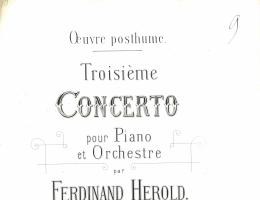Concerto for piano and orchestra no. 3 in A major
Allegro maestoso – Andante – Rondo. Moderato
The title page of the autograph score of the Concerto in A major, now kept at the Bibliothèque Nationale de France, is “February/1813/Rome”. The information was confirmed in a letter from Hérold to his mother dated 28 February 1813, in which he wrote: “Although I’m not working a great deal, I have composed a new concerto here that has gone down very well (you see my modesty).” The work calls for 2 flutes, 2 oboes, 2 horns, 2 bassoons and strings in addition to the solo piano. It has a traditional three-movement form: Allegro maestoso (2/2, A major), Andante (3/4, F sharp minor) and Rondo. Moderato (2/4, A major). The first movement is perfectly classical in structure and focuses the listener’s interest in particular on the second theme, which is Schubertian in its refinement. The development, with its initial virtuosic octave runs, already heralds passages by Mendelssohn. The originality of the work resides above all in the second movement, which is written for solo violin and piano, without any orchestral intervention. This ternary-form Andante in F sharp minor allows the two instruments to carry on a dialogue in the style of a sonata, since the violin is able to accompany the piano in long note values. A cadential point reaches dizzying heights, while a repeat of the first motif concludes this particularly expressive passage in a mood of restrained melancholy. The finale—a rondo—is based on a witty theme anchored on a rustic pedal in fifths. Hérold moves away from this in contrasting passages, which show that he is not afraid to use remote modulations, a hallmark of his forward-looking aesthetic which a contemporary like Gossec censured in a letter sent to the Villa Medici: “Melody, melody! That’s the refrain of sensible people and the healthy portion of the public. Harmonic detours, barbaric transitions, extravagant chromaticism, that’s the refrain of madmen and lunatics. […] [Will they be cured] of this modulating fever, this delirium born of a love of chromaticism? Only time will tell.”

